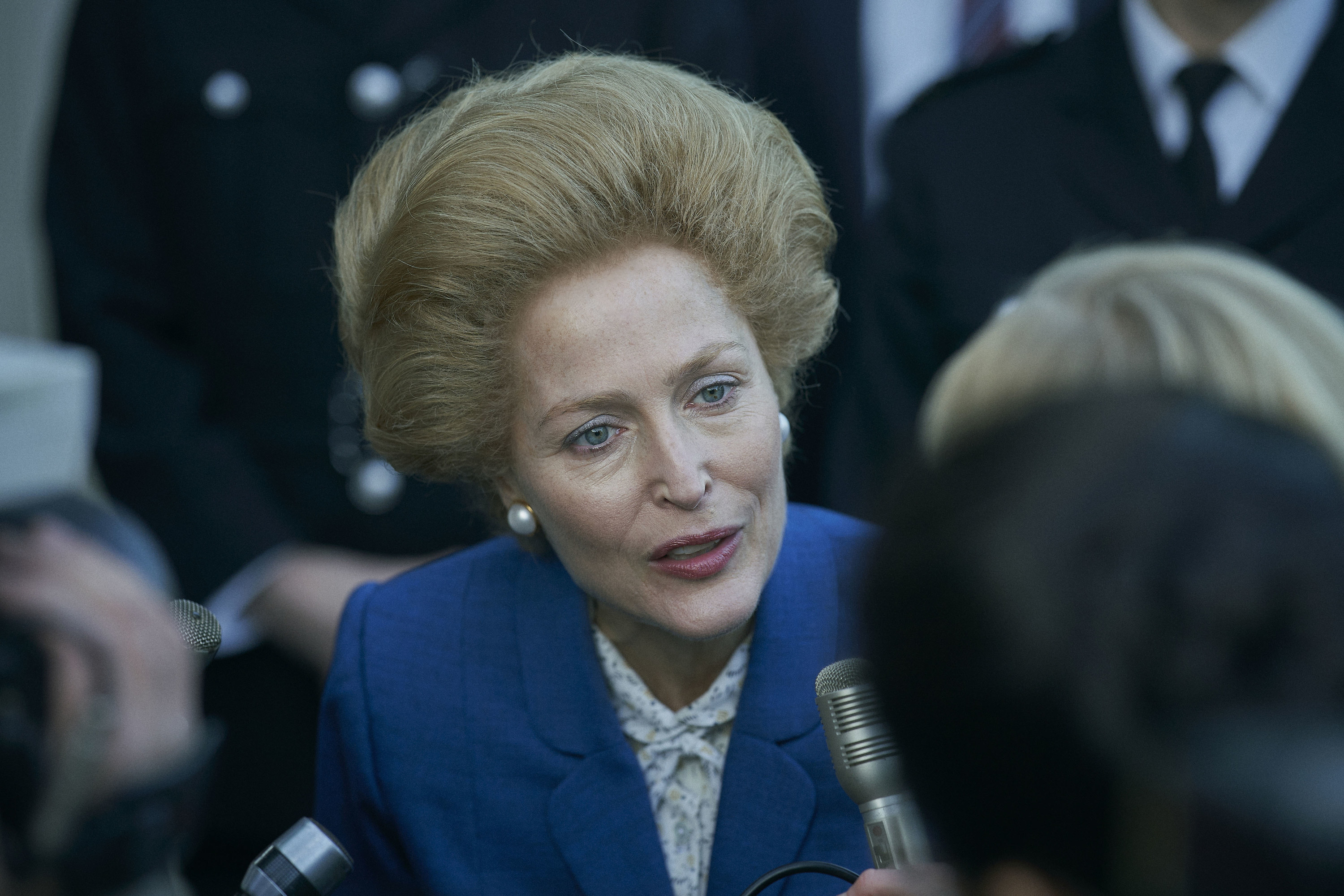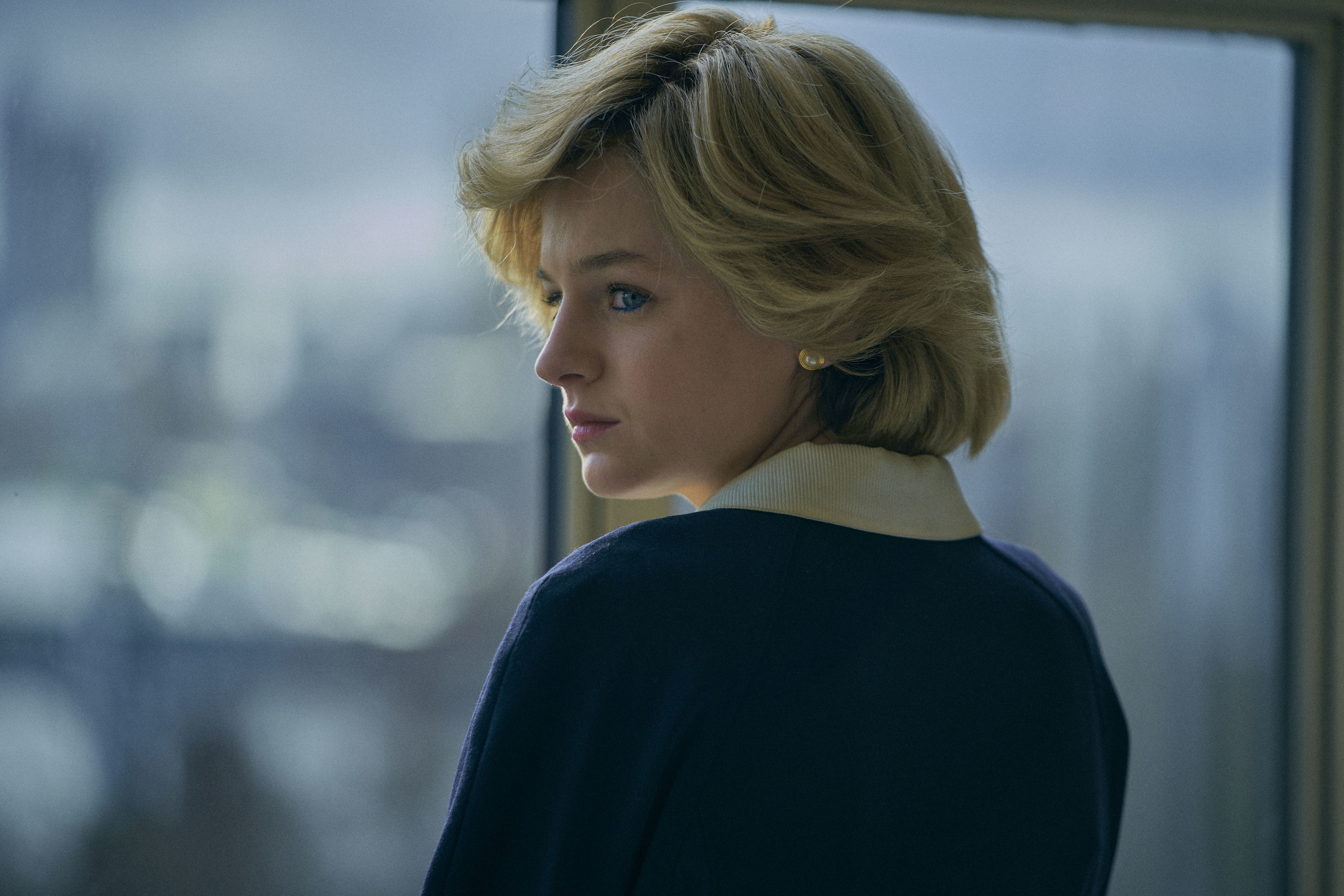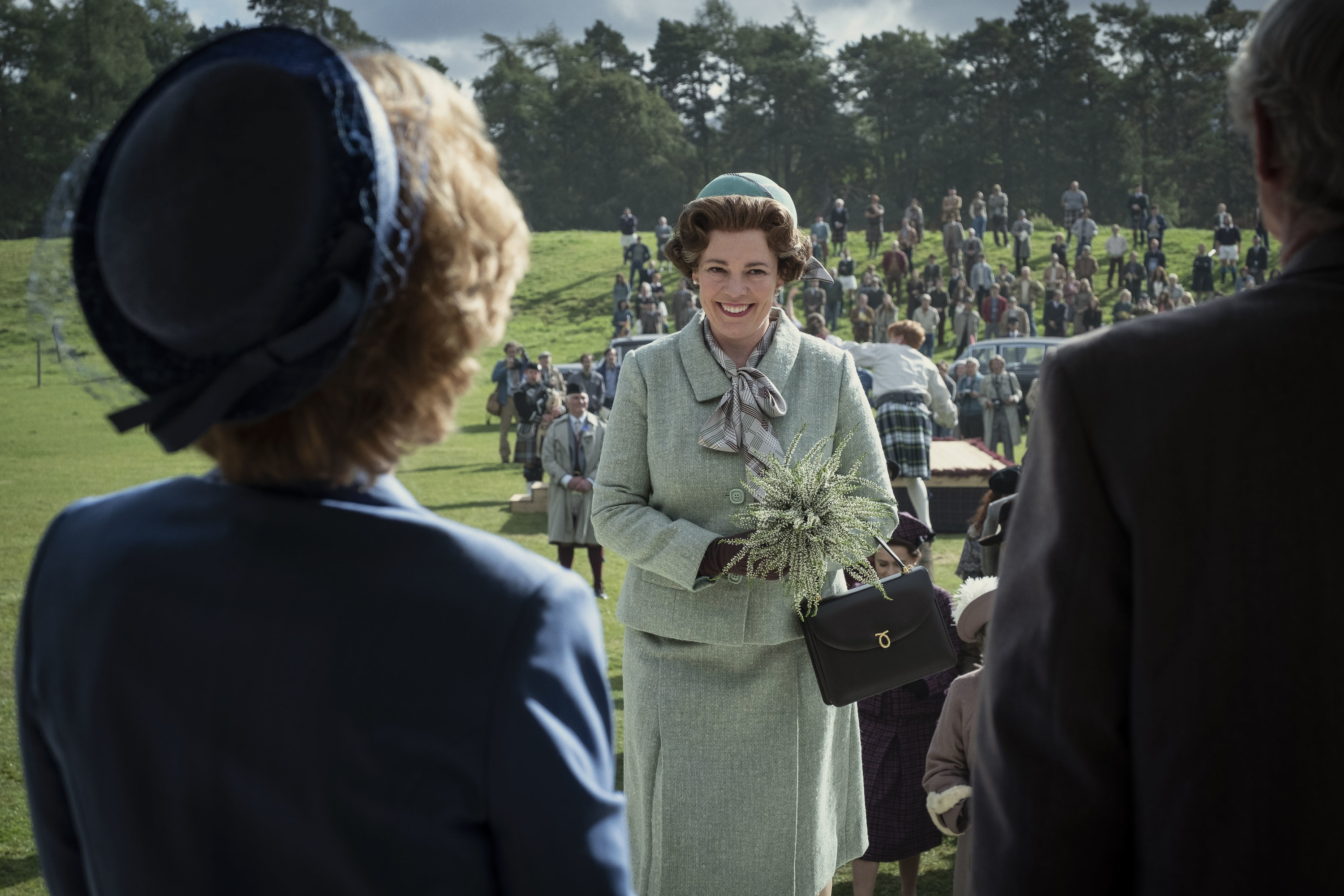
Olivia Colman needed a bucket. It was the final day of shooting for the fourth season of The Crown, and she was going to be sick. This was back in March, when the coronavirus pandemic had begun shutting down film sets, so producers of Netflix’s royal drama were rushing to wrap. Colman was acting as Queen Elizabeth II opposite Prince Charles (Josh O’Connor) in a fiery mother-son encounter when she suddenly felt nauseous.
“There were buckets hidden around the set,” Colman told BuzzFeed News and other outlets at a virtual press conference in August.
“You were very ill,” said Helena Bonham Carter, who plays Princess Margaret, the Queen’s younger sister. “It could have been COVID!”
“I don’t think so, because no one else went down with it. I think the whole point of COVID is a shitload of people go down with it!” said Colman, using language that was definitely not the Queen’s English. “I was really, really unwell. I was shivering [and] then had to chat with Josh. And I think the fear on his face is more than I might go blurgh!”
“It’s one time I really got all my lines,” she added, “because I needed to get it done and go lie down somewhere.”
That an illness — potentially a deadly virus — was creeping onto the set of The Crown is especially fitting, given this fourth season is full of invading outsiders posing a threat to the monarchy. Some, like the young Diana Spencer (Emma Corrin), are invited in, unaware she’s a ticking time bomb that will much later plunge the royals into an existential crisis. Others, like Buckingham Palace trespasser Michael Fagan (Tom Brooke), invite themselves in unannounced in the dead of night because they’re already in an existential crisis of their own. As the 1980s progress in Margaret Thatcher’s Britain, so too does republicanism in Northern Ireland and Australia, sometimes with deadly results for the royals. The new world is slowly creeping beyond the gilded but shoddy palace walls.
Maybe it’s just because I’m an Australian in my thirties and the show is finally introducing things that occurred in my lifetime (Young William and Harry! A reference to the beer-drinking record of Australian Prime Minister Bob Hawke!), but bingeing this season of The Crown felt uniquely bizarre. It’s very unsettling to watch a period piece slowly but surely catch up to the modern era.
It’s very unsettling to watch a period piece slowly but surely catch up to the modern era.
Season 1’s overhead shots of Princess Margaret (then played by Vanessa Kirby) riding on horseback to visit her divorced (and hence forbidden!) lover as swelling orchestral music plays have now been replaced by images of Diana leaning out of a black cab on the way to a disco with her girlfriends while Stevie Nicks blares. The costumes and hair are a lot less glamorous and a lot more, well, ’80s. Everything just feels drab.
But the genius of The Crown — and something I only truly appreciated this season — is how it plays catch-up as the royals themselves continue to resist modernity at every turn.
The passage of time is a theme across the series, but the Windsors are often stubbornly resistant to it. Everyone in The Crown is a period character in a period piece in a world that is rapidly moving toward the present day. The generation in their early twenties in the show’s first season are now in their fifties, plumper and with grayer hair but still constrained by the archaic system they inherited, which they are now destined to impose on their own miserably unhappy adult children.

For the Queen, this season’s chief outsider is Thatcher (Gillian Anderson) who is swept into 10 Downing Street in the season premiere and immediately positioned as an antagonist to Elizabeth in a way no other prime minister before has been. (The show skips the 1976–1979 tenure of James Callaghan — boring!)
The season’s second episode is a delightful comedy of manners set at Balmoral Castle, the monarch’s Scottish estate, wherein the Thatchers fail a series of unwritten tests that expose them as terribly middle-class — and the royals as just, well, terrible. “I’m struggling to find any redeeming features in these people at all,” Thatcher confides to her husband. “They aren’t sophisticated or elegant or cultured or anything close to an ideal.”
As the Iron Lady, Anderson is icy and menacing, yet undeniably funny. When she turns up at a hunting party in a bright royal blue outfit and heels, I screamed. When she begins cooking dinner for her military leadership as they plot the recapture of the Falkland Islands, my jaw was on the floor.
But compared to Meryl Streep, who won an Oscar for playing Thatcher in 2011’s The Iron Lady, Anderson’s performance is almost subdued — well, at least as subdued as one can be playing someone so cartoonishly conservative. With her hair sprayed into a helmet and never without sensible heels, Anderson’s Thatcher prowls through the corridors of power. She masterfully captures her grit and steel, but also her ruthlessness, her heartlessness, and her willful ignorance to the suffering she imposes on the nation’s people in the name of feeding them their “economic medicine.”
Nowhere is this made more evident than “Fagan,” an episode unlike any other in The Crown, where we spend almost the entire 50 minutes with the desperate and increasingly troubled man who made international headlines in 1982 by breaking into the palace, making his way past lax security and into the Queen’s bedroom, where he and the sovereign spoke for several minutes before he was detained. It’s the first time in the series where viewers get to really follow someone who isn’t privileged or powerful, and the long unemployment lines and grim public housing are an indictment of the entire British class system. “I just want to talk to you. That’s all,” he tells a terrified Queen as he sits, bleeding, on her bedside, “[Just] to tell you what’s going on in the country because either you don’t know or you don’t care.”

As the show ages, its juiciest plotlines — the sex, the scandal — are naturally inherited by the younger characters. Like the Marvel Cinematic Universe, The Crown has slowly expanded to introduce new royals who gradually demand more screentime. Season 2 ended with an episode exploring the horrific schooling experience of young Charles (Julian Baring), and it’s not unlikely the show’s final two seasons will feature William and Harry more extensively. But this season is mostly about Charles, Diana, and, of course, Camilla (Emerald Fennell).
The young Diana first appears in this season’s opening minutes as Charles arrives to pick up her older sister for a date. Dressed as Puck, the mischievous wood sprite from A Midsummer Night’s Dream, she too is about to cause chaos in a world of lovers and royal weddings. “Then she comes along,” observes Bob Hawke, the Australian leader played by Richard Roxburgh, “the perfect wife, the perfect princess, and the whole place goes nuts. It’s the power of fairy tales.”
Of course, The Crown is dedicated to unraveling fairy tales, showing the human toll that the illusion of monarchy requires, and in Diana this harm is evident. Desperately lonely and rejected by a husband who never truly loved her but is still jealous of the attention she receives, Diana roller-skates through Buckingham Palace, dances alone in a fevered frenzy, and develops bulimia. An outsider who married in, her very mind and body seem to be allergic to this charade.
In her first major role, Corrin is shockingly good as the iconic people’s princess. She nails Diana’s coy, slightly crooked smile, one that was always meant to convey humility but which deep down spoke to the restrained joy she felt in working a crowd, in realizing she could find love and admiration in the public as her new family stubbornly deprived her of it. “If you show me love, approval, and acceptance, everyone else will follow,” she desperately tells a horrified Queen. “That’s all I want. That’s all any of us want from you. Is it too much to ask?”
One of the more interesting parallels that the show draws this season is between Diana and Prince Philip (Tobias Menzies), once an invasive species himself. The pair share a solo hunting trip together, and the season’s final tense scene is between them: one an outsider who learned to adapt and the other who can’t, or won’t. “He is very beguiled by this beautiful young woman and doesn’t really register the turbulence that is clearly in her,” Menzies said at the August press conference. “And obviously once that is kind of unleashed within the fabric of her family, it ends up being very destructive to the family and obviously fatal to herself.”

All the time spent with Diana and Thatcher, though, means that Elizabeth, Margaret, and Philip feel almost sidelined this season. Menzies doesn’t get any real episodes centered around him, while Bonham Carter only gets one. (Still, she manages to do better acting with a simple quiver of her lip than most in the industry can dream of.)
Colman is a regular central presence, of course — but when the season’s final shot is a close-up of Diana, it’s clear the show has found more interesting subjects. Most of the action seems to happen around Elizabeth this season, rather than being driven by her, save for an episode where she battles Thatcher over an anti-apartheid statement where the most exciting sequence is a fight montage about synonyms. This speaks to the season’s weakest point as a whole: the hurried glibness with which it addresses some of the most urgent problems of the 1980s. The economic crisis is keenly felt, but Northern Irish republicanism seems to vanish after the first episode. It’s also quite galling to watch an entire episode about apartheid without any Black characters or any real depictions of its horrors. By virtue of its subjects, The Crown may be the whitest show on TV, and that is really saying something.
By virtue of its subjects, The Crown may be the whitest show on TV, and that is really saying something.
Still, Colman remains a delight, and I could watch her read a phone book. As was on display in her Oscars speech almost two years ago, she has such a terrifically warm presence that occasionally sneaks through, even in such a tightly wound role. She has one line reading about Billy Joel that deserves an Emmy alone.
But it’s clear where the next two seasons are going to go as Imelda Staunton takes over as Elizabeth and Australian actor Elizabeth Debicki is passed Diana’s baton. “Perhaps someone like Diana is best placed to … connect with the modern world,” Colman says as the Queen in one episode. “And isn’t that how the crown survives and stays relevant? By changing with the modern times?” Her flash of self-awareness is fleeting at best.
For a long time, I felt embarrassed that an Australian Republican like myself (i.e., someone who longs to see a head of state who is actually Australian) was still obsessively drawn to The Crown, tracking casting news and rewatching trailers. Now, after this season, I feel a lot less guilty. I realize the show perfectly captures my relationship with the monarchy: It’s engrossed with them as curiosities but also reveals them as total antiques.
“That’s the thing about this place,” Fagan, the intruder, says after breaking into the palace and taking a look around. “It’s even posher than you’d think — and yet more run-down.” ●
